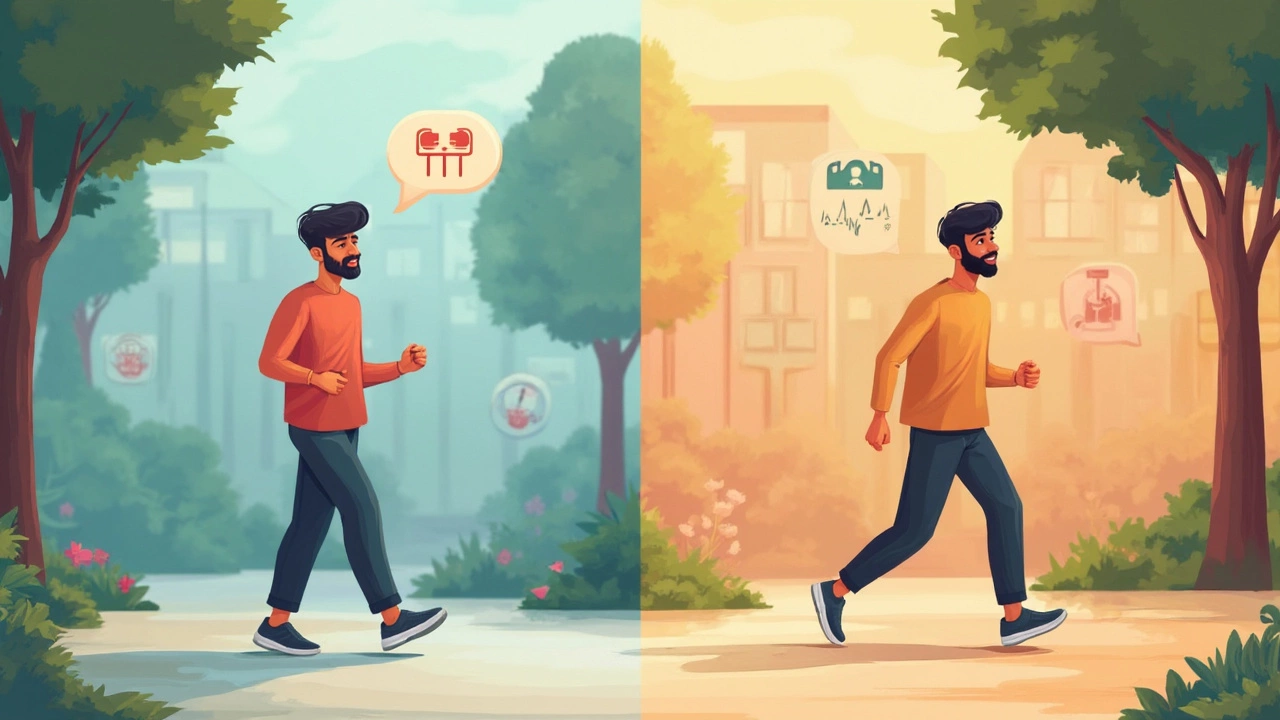Is 1 Hour of Walking Enough Cardio? What You Need to Know
 Apr, 24 2025
Apr, 24 2025
There’s a reason you see people walking in parks, neighborhoods, and even laps inside shopping malls. Walking is easy, it’s free, and pretty much anyone can start without fancy equipment. But is spending a whole hour on your feet enough to count as solid cardio?
For most folks, cardio means getting your heart pumping. Doctors and trainers will tell you that something is cardio if it raises your heart rate enough to make you breathe faster but still lets you talk. Simple, right? But walking comes in all flavors, from a slow stroll to a brisk power walk. Whether an hour of it ticks the cardio box depends on how hard you’re actually going.
- What Makes Exercise 'Cardio'?
- What Happens to Your Body in 1 Hour of Walking
- Walking vs. Other Cardio: How Does It Compare?
- How to Make Walking More Effective
- Is Walking Enough for Your Fitness Goals?
What Makes Exercise 'Cardio'?
When people say something is "cardio," they really mean it gets your heart beating faster and your lungs working harder for a good chunk of time. The whole point is to make your body use more oxygen, which then trains your heart and lungs to get stronger over time. If you’re just barely moving or able to sing your favorite song without pausing for breath, it probably doesn’t count.
Cardio exercises use big muscle groups over and over, like your legs during a walk, jog, bike ride, or swim. What sets them apart is the steady, moderate-level effort—they’re not just bursts of energy, but something you keep up for at least 10 minutes straight, and usually a lot longer.
- Your heart should beat faster, but you should still be able to talk (not sing!)
- You’ll likely break a small sweat, especially when it’s warm out
- You notice deeper, faster breathing
Experts like the American Heart Association say cardio can be anything that gets your heart rate to about 50-70% of its max for moderate activity, and 70-85% for vigorous stuff. For most adults, that means your heart is hitting somewhere from 90 to 150 beats per minute during exercise, depending on your age. You don’t need a fancy watch to check—just notice if you can talk in sentences but not hold a phone call, you’re likely doing true cardio.
| Exercise Type | Counts as Cardio? |
|---|---|
| Brisk walking | Yes, if it’s fast enough |
| Strolling slowly | No, not usually |
| Jogging | Yes |
| Shopping at the mall | Only if you work up a sweat |
| Swimming laps | Yes |
So, just walking won’t always hit the cardio mark—it really depends on the pace and the effort you put in. But once you hit a brisk speed and keep it up, your trusty walk absolutely fits the cardio bill.
What Happens to Your Body in 1 Hour of Walking
When you spend an hour walking, your whole system perks up. In the first few minutes, your body starts to loosen up stiff muscles and joints. Blood flow increases, getting more oxygen to your brain, which explains why people feel more alert after a good walk.
By the halfway mark, your heart and lungs start to work harder, especially if you’re picking up the pace. This actually trains your heart muscle much like any other workout. Most people will notice their heart rate rising into what’s called the “moderate intensity” zone—the sweet spot for improving cardiovascular health.
If weight loss is on your mind, here’s some real talk: walking an hour at a moderate pace (roughly 3-4 mph for most adults) can burn between 210 and 360 calories, depending on your weight, speed, and terrain. Walking faster or adding hills pushes this number even higher. Just check out these rough numbers:
| Weight | Calories Burned (1 hour, 3.5 mph) |
|---|---|
| 130 lbs | 210 |
| 155 lbs | 267 |
| 180 lbs | 312 |
| 205 lbs | 360 |
Besides burning calories, an hour of walking helps lower blood pressure, manages blood sugar, and even gives your mental health a boost. Studies have shown regular walks cut down anxiety and lift your mood, thanks to endorphins flooding your brain. Walking outdoors? Even better for your mind.
- Boosts metabolism for hours after you’re done
- Improves balance and leg strength
- Keeps joints flexible, lowering arthritis risk
- Reduces risk of heart disease with regular practice
What’s the catch? To get these full benefits, you want to stay consistent and keep your walks brisk enough that you feel a bit challenged, not just coasting along.

Walking vs. Other Cardio: How Does It Compare?
Not all cardio hits the same. When it comes to walking, it’s super accessible—but how does it stack up against stuff like running, cycling, or even swimming?
If we look at calorie burn, which many people care about for weight loss, let’s break down a typical hour at a steady pace. Walking (at about 3-4 miles per hour) burns roughly 250–350 calories for an average-sized adult. Now, compare that to running, which can torch anywhere from 500 up to 900 calories per hour—sometimes more if you’re sprinting or going uphill.
| Activity | Average Calories Burned (1 hour, 155 lbs) |
|---|---|
| Walking (3.5 mph) | 267 |
| Running (6 mph) | 704 |
| Cycling (moderate effort) | 498 |
| Swimming (moderate) | 423 |
| Elliptical trainer | 670 |
Of course, calorie burn isn’t everything. Walking is much gentler on your joints than running or high-impact moves in classes. That’s a big reason why doctors recommend it to people just starting out or anyone dealing with knee or hip issues.
According to
Mayo Clinic experts say, “Walking, like other cardio exercises, can help you improve your endurance, heart health, and mood—but the benefits add up when you stick with it, especially at a brisk pace.”
But don’t assume you have to pick one “best” option. Walking might not get your heart pounding as hard as a spin class, but it’s realistic to do daily. Plus, less recovery needed means you’re likely to keep showing up compared to killer workouts that leave you wiped. And if you walk with friends or listen to music, it barely feels like a chore.
So, is walking enough? It can absolutely count as real cardio, especially if you go brisk or toss in a few hills. If you want serious sweat or you’re aiming to train for a race, mixing walking with cycling, jogging, or swimming will crank things up a notch. But for general health and a boost of energy, that daily hour of walking covers a lot of bases.
How to Make Walking More Effective
If you really want to get the most out of your daily walking routine, it’s not just about how long you’re out there—it’s about how you do it. A few tweaks can turn a basic stroll into a legit cardio workout that actually delivers the benefits you’re looking for.
First up: speed matters. A slow walk is better than sitting, but to get your heart into that cardio zone, try to keep your pace around 3 to 4 miles per hour (that’s brisk enough to carry on a conversation, but you’d have to catch your breath every now and then). If you use a fitness watch or your phone, check for a pace that’s labeled as “moderate” or higher.
Want to boost the intensity even more? Here are some smart ways to level up your walking session:
- Add intervals: Every few minutes, pick up your pace for 30–60 seconds, then slow back down. This burns more calories and strengthens your heart.
- Head for the hills: Walking on an incline, whether it’s outside or on a treadmill, turns a basic walk into a real workout for your legs and lungs.
- Use your arms: Swing them more vigorously or use light hand weights to engage your upper body and get your heart rate up.
- Try walking poles: Nordic walking (using poles) gets your whole body moving. Studies show it can help you burn up to 46% more calories than regular walking.
- Mix up the terrain: Gravel, grass, or trails make your body work harder than flat, even pavement.
Curious what kind of difference these changes can make? Check this out:
| Walking Type | Calories Burned (1 Hour, 160 lbs) |
|---|---|
| Slow (2 mph, flat) | 204 |
| Brisk (4 mph, flat) | 314 |
| Incline (3.5 mph, uphill) | 430 |
If you want walking to give you all the fitness and health perks, focus on ramping up either your speed, the slope, or how much of your body you’re working. Little changes add up!

Is Walking Enough for Your Fitness Goals?
Let’s get honest—whether walking is enough as your main cardio really depends on what you want to achieve. If your goal is just to move more, hit your daily step count, or maintain your current weight, an hour a day is usually plenty. Studies have shown that briskly walking for 30-60 minutes most days of the week can help lower blood pressure, cut heart disease risk, and boost your mood.
If you’re hoping to shed a lot more pounds or build serious endurance, plain old walking might need a boost. Walking burns about 200-350 calories per hour depending on your speed and weight. Check out this simple chart for a glimpse at the calorie burn:
| Walking Speed (mph) | Calories Burned in 1 Hour (150 lb person) |
|---|---|
| 2.5 (easy pace) | 190 |
| 3.5 (brisk pace) | 270 |
| 4.0+ (very brisk) | 320 |
So, if you want results like major fat loss or a big jump in cardiovascular fitness, it’s smart to bump up your intensity. Mix in some hills, try interval walks, or add weights to make the most out of your exercise time. And remember, your body adapts. If you keep doing the same thing every day, you’ll plateau, meaning progress slows down. So shake it up now and then.
- For general health and a happier mindset: 1 hour of walking is enough.
- For significant weight loss: Pair walking with diet tweaks and strength training.
- For better cardio endurance: Walk faster, or slip in jogging or cycling sessions.
Walking works wonders, but there’s no one-size-fits-all solution. Take stock of your goals, and challenge yourself a little more if you want bigger results. The best kind of exercise is the one you’ll stick with—and for a lot of people, walking fits the bill.
